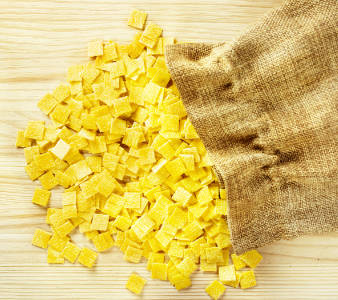Pasta Category

To find substitutions for pasta in general, click here.
A staple of Italian cuisine, pasta is made with a dough that's kneaded and then fashioned into hundreds of different shapes and sizes. The tiniest shapes are often used in soups, long ribbons or strands with sauces, and tubes and fanciful shapes in casseroles and pasta salads. Some shapes are large enough to be stuffed and baked, and others, like ravioli, come already stuffed.
Most pasta is made with semolina, a hard wheat flour, but some producers make corn pasta, rice pasta, spelt pasta, and kamut pasta. These alternative grains yield a mushier pasta, but they're a boon to people with wheat allergies.
While dried pasta is usually vegan, egg pasta, along with many fresh pastas, are made with eggs, which gives the finished dish a richer flavor, a softer texture, and a lovely yellow color. Dried pasta is sturdier than egg pasta or fresh pasta, and is the best choice for heavy sauces, pasta salads, and casseroles. Fresh pasta works best with cream or cheese sauces. One pound dried pasta yields the same amount of cooked pasta as 1 1/2 pounds fresh pasta.
Italian for pasta lovers
The Italian suffixes "ini," "elli," "illi," or "etti" mean smaller (e.g., spaghettini is a thin version of spaghetti), while "oni," "one," or "otti" mean larger.
Ribbed pasta sometimes has a "rigate" or "rigati" adjective behind the pasta name (e.g., penne rigate or rigatoni rigati).
Smooth pasta sometimes has a "lisce" or "lisci" adjective behind the pasta name (e.g., penne lisce or ditali lisci).
Fresca means fresh. All' uovo means the pasta is made with eggs.
How to cook pasta
Different kinds of pasta cook at different rates, so select shapes of similar sizes if you're combining them. If you use a low-quality pasta, be sure to cook it in plenty of water to prevent it from getting gummy.
Use lots of water when cooking pasta, at least a gallon per pound. You can add salt to the water if you wish, but don't add oil. Bring the water to a rolling boil before adding the pasta. When the water returns to a boil, lower the heat to maintain a low boil. Stir occasionally to keep the pasta from sticking together. Don't cover the pot.
Pasta is ready when it's "al dente" ("to the tooth"), which means it should be cooked completely through, yet firm enough to offer some resistance to your bite. Drain the pasta in a colander, but don't rinse it unless you plan to use it in a casserole or pasta salad. Reserve a small amount of the flavorful cooking liquid in case the pasta becomes too dry and needs to be moistened. Serve it as soon as possible.
Don't freeze cooked pasta unless it's in a baked casserole.
How to select pasta:
Pasta salads: Use short, thick pasta tubes or pasta shapes. Common choices include penne, macaroni, fusilli, ruote, rotini, cavatelli, conchigliette, or gemelli. Don't use egg pasta or fresh pasta.
Casseroles: Use pasta tubes with thick walls, like macaroni or penne, or sturdy pasta shapes, like rigatoni, fusilli, or gemelli, or lasagne. Cook them for two-thirds of the recommended time in water, then let them finish cooking in the oven.
For stuffing: Choose large pasta tubes like cannelloni, manicotti, or tufoli.
Heavy sauces: Choose thick pasta ribbons, like fettuccine or linguine, or sturdy pasta rods, like perciatelli.
Light, smooth sauces: Choose slender pasta rods, like spaghetti or vermicelli.
Cream or butter sauces: Choose fresh pasta ribbons, like fresh fettuccine or fresh pappardelle.
Dishes with chunky, bite-sized ingredients: Choose pasta tubes or pasta shapes that can capture and retain bits of meat, cheese, and vegetables, like farfalle, radiatore, fusilli, penne rigate, macaroni, rigatoni, ziti, ruote, conchiglie, rotini, or cavatelli.
Soups: Choose a soup pasta, like orzo, acini di pepe, orecchiette, tubettini, conchiglette, or ditalini.









































































































































































































































































































































































